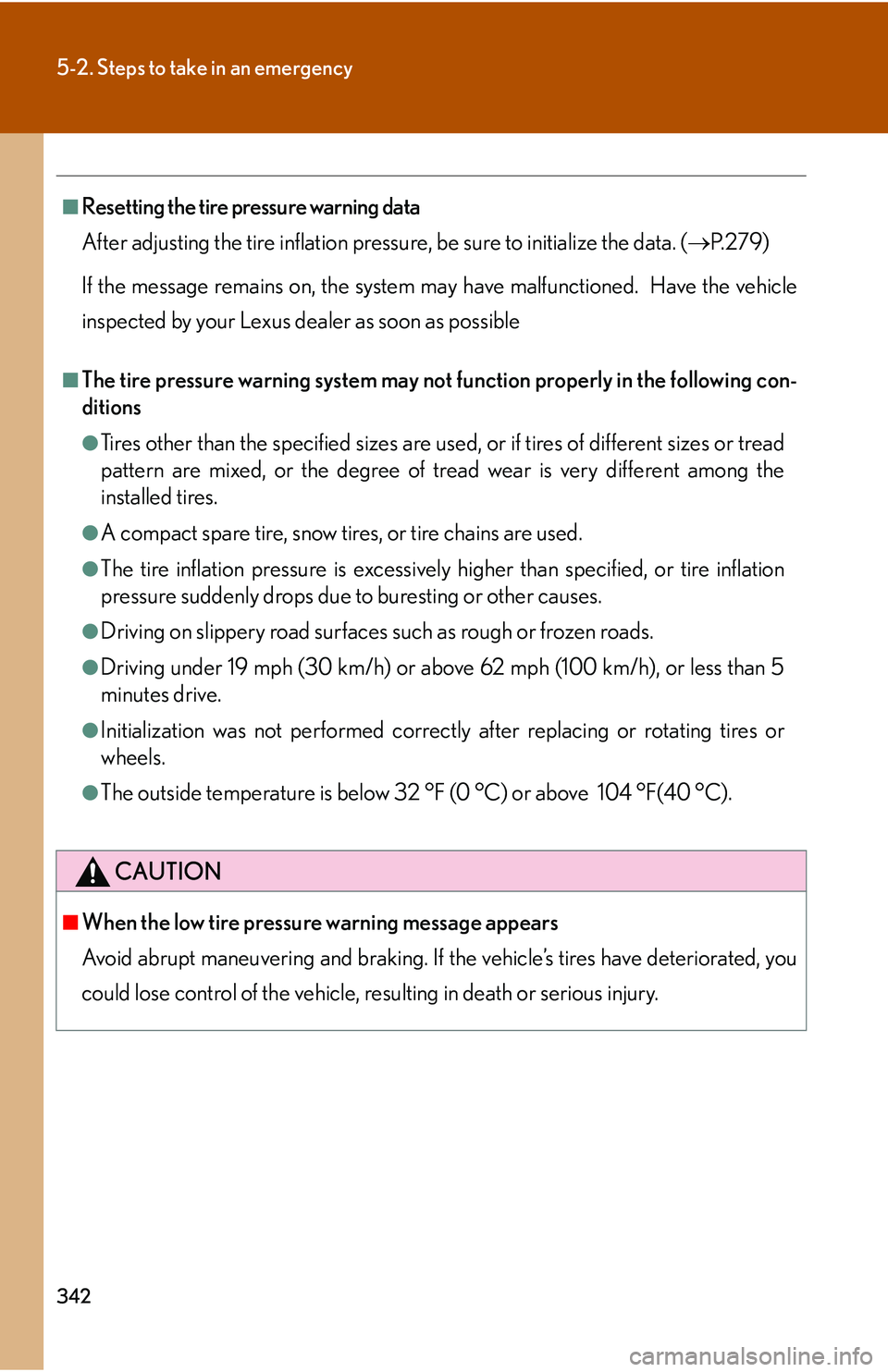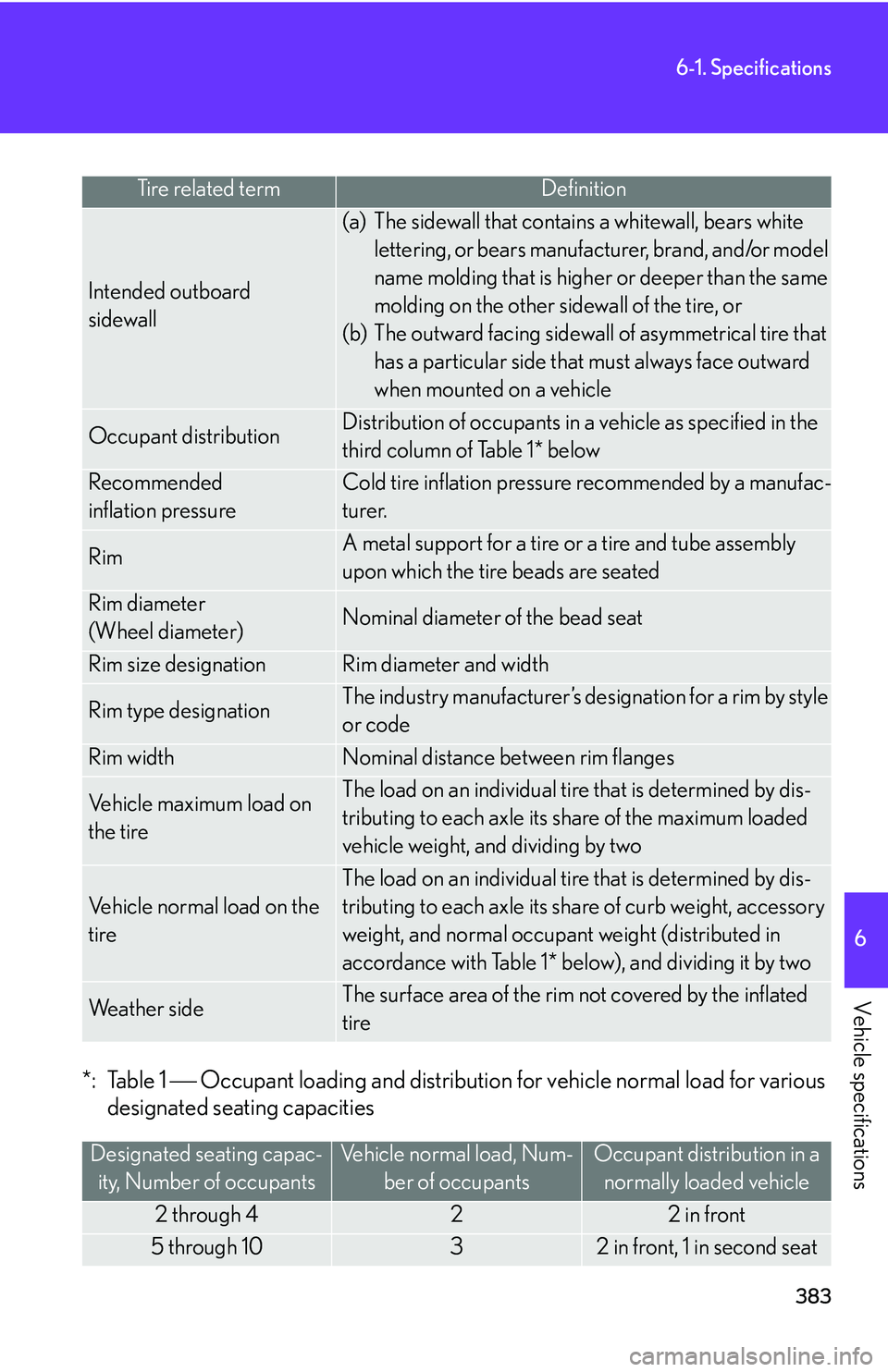Page 304 of 419
288
4-3. Do-it-yourself maintenance
CAUTION
■When replacing wheels
●Do not use wheels other than the manufacturer’s recommended wheel or wheel
size, as this may result in loss of handling control.
●Never using an inner tube in a leaking wheel which is designed for a tubeless tire.
Doing so may result in an accident, causing death or serious injury.
Page 358 of 419

342
5-2. Steps to take in an emergency
■Resetting the tire pressure warning data
After adjusting the tire inflation pressur
e, be sure to initialize the data. (P. 2 7 9 )
If the message remains on, the system may have malfunctioned. Have the vehicle
inspected b
y your Lexus dealer as soon as possible
■The tire pressure warning system may not function properly in the following con -
ditions
●Tires other than the sp ecified sizes are used, or if tires of different sizes or tread
pattern are mixed, or the degree of tread wear is very different among the
installed tires.
●A compact spare tire, snow tires, or tire chains are used.
●The tire inflation pressure is excessively higher than specified, or tire inflation
pressure suddenly drops due to buresting or other causes.
●Driving on slippery road surfaces such as rough or frozen roads.
●Driving under 19 mph (30 km/h) or above 62 mph (100 km/h), or less than 5
minutes drive.
●Initialization was not performed correctly after replacing or rotating tires or
wheels.
●The outside temperature is below 32 °F (0 °C) or above 104 °F(40 °C).
CAUTION
■When the low tire pressure warning message appears
Avoid abrupt maneuvering and braking. If th
e vehicle’s tires have deteriorated, you
could lose control of the vehicle, resulting in death or serious injury.
Page 386 of 419

370
6-1. Specifications
Tires and wheels (Type A)
Tires and wheels (Type B)
Ti r e s i z eP225/55R17 95H
Tire inflation pressure
(Recommended cold
tire inflation pressure)
Driving in normal conditions
32 psi (220 kPa, 2.2 kgf/cm2 or bar)
Driving in high speeds above 100 mph (160
km/
h)
(in countries where such speeds are permitted
b
y law)
Add 3 psi (20 kPa, 0.2 kgf/cm
2 or bar) to
the front tires and rear tires. Never exceed
the maximum cold tire inflation pressure
molded on the tire sidewall.
Wheel size17 7 1 /2 JJ
Wheel nut torque76 f t•lbf. (103 N•m, 10.5 kgf•m)
Ti r e s i z e245/45R18 96W
Tire inflation pressure
(Recommended cold
tire inflation pressure)
Driving in normal conditions
33 psi (230 kPa, 2.3 kgf/cm2 or bar)
Driving in high speeds above 100 mph (160
km/
h)
(in countries where such speeds are permitted
b
y law)
Add 6 psi (40 kPa, 0.4 kgf/cm
2 or bar) to
the front tires and rear tires. Never exceed
the maximum cold tire inflation pressure
molded on the tire sidewall.
Wheel size18 7 1 /2 JJ
Wheel nut torque76 f t•lbf. (103 N•m, 10.5 kgf•m)
Page 387 of 419
371
6-1. Specifications
6
Vehicle specifications
Tires and wheels (Type C)
Ti r e s i z eP245/45R18 96V
Tire inflation pressure
(Recommended cold
tire inflation pressure)
Driving in normal conditions
33 psi (230 kPa, 2.3 kgf/cm2 or bar)
Driving in high speeds above 100 mph (160
km/
h)
(in countries where such speeds are permitted
b
y law)
Add 6 psi (40 kPa, 0.4 kgf/cm
2 or bar) to
the front tires and rear tires. Never exceed
the maximum cold tire inflation pressure
molded on the tire sidewall.
Wheel size18 7 1 /2 JJ
Wheel nut torque76 f t•lbf. (103 N•m, 10.5 kgf•m)
Page 392 of 419
376
6-1. Specifications
Tire information
Ty p i c a l t i r e s y m b o l s
Tire size(P.377 )
DOT and Tire Identification Number (TIN) ( P.377 )
Location of tread wear indicators ( P.278 )
Tire ply composition and materials
Plies are layers of rubber-coated parallel cords. Cords are the strands
which form the plies in a tire.
Radial tires or bias-ply tires
A radial tire has “RADIAL” on the sidewall. A tire not marked “RADIAL” is a
bias-ply tire.
“TUBELESS” or “TUBE TYPE”
A tubeless tire does not have a tube and air is directly filled in the tire. A tube
type tire has a tube inside the tire and the tube maintains the air pressure.
Load limit at maximum cold tire inflation pressure ( P.283 )
1
2
3
4
5
6
7
Page 393 of 419
377
6-1. Specifications
6
Vehicle specifications
Typical DOT and tire identification number (TIN)
“DOT” symbol*
Tire Identification Number (TIN)
Tire manufacturer’s identifica -
tion mark
Tire size code
Manufacturer’s optional tire
type code (3 or 4 letters)
Manufacturing week
Manufacturing year
* The “DOT” symbol certifies that the tire conforms to applicable
Federal Motor Vehicle Safety
Standards.
Maximum cold tire inflation pressure ( P.364 )
This means the pressure to which a tire may be inflated.
Uniform tire quality grading
For details, see “Uniform tire quality grading” that follows.
Summer tire or all season tire (P.379 )
An all season tire has “M+S” on the sidewall. A tire not marked “M+S” is a
summer tire.
8
9
10
1
2
3
4
5
6
7
Page 394 of 419
378
6-1. Specifications
Tire size
■Typical tire size information
The illustration indicates typical
tir
e size.
Tire use
(P = Passenger car, T = Tempo -
rary use)
Section width (in millimeters)
Aspect ratio
(tire height to section width)
Tire construction code
R = Radial, D = Diagonal
Wheel diameter (in inches)
Load index
(2 digits or 3 digits)
Speed symbol
(alphabet with one letter)
■ T
ire measurements
Section width
Ti r e h e i g h t
Wheel diameter
1
2
3
4
5
6
7
8
1
2
3
Page 399 of 419

383
6-1. Specifications
6
Vehicle specifications
*: Table 1 Occupant loading and distribution for vehicle normal load for various
designated seating capacities
Tire related termDefinition
Intended outboard
sidewall
(a) The sidewall that contains a whitewall, bears white
lettering, or bears manufacturer, brand, and/or model
name molding that is higher or deeper than the same
molding on the other sidewall of the tire, or
(b) The outward facing sidewall of asymmetrical tire that
has a particular side that must always face outward
when mounted on a vehicle
Occupant distributionDistribution of occupants in a vehicle as specified in the
third column of Table 1* below
Recommended
inflation pressure
Cold tire inflation pressure recommended by a manufac -
turer.
RimA metal support for a tire or a tire and tube assembly
upon which the tire beads are seated
Rim diameter
(Wheel diameter)Nominal diameter of the bead seat
Rim size designationRim diameter and width
Rim type designationThe industry manufacturer’s designation for a rim by style
or code
Rim widthNominal distance between rim flanges
Vehicle maximum load on
the tireThe load on an individual tire that is determined by dis -
tributing to each axle its share of the maximum loaded
vehicle weight, and dividing by two
Vehicle normal load on the
tire
The load on an individual tire that is determined by dis-
tributing to each axle its share of curb weight, accessory
weight, and normal occupant weight (distributed in
accordance with Table 1* below), and dividing it by two
We a t h e r s i d eThe surface area of the rim not covered by the inflated
tire
Designated seating capac -
ity, Number of occupants
Vehicle normal load, Num -
ber of occupants
Occupant distribution in a
normally loaded vehicle
2 through 422 in front
5 through 1032 in front, 1 in second seat